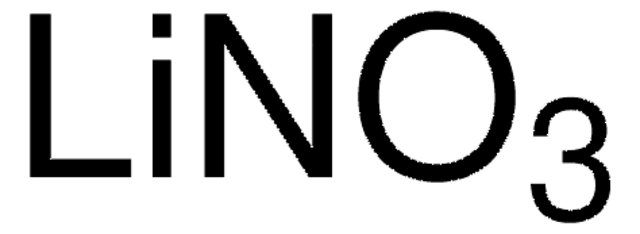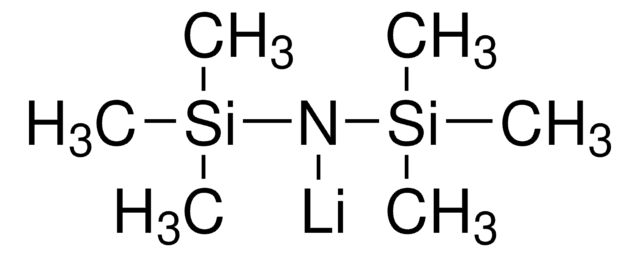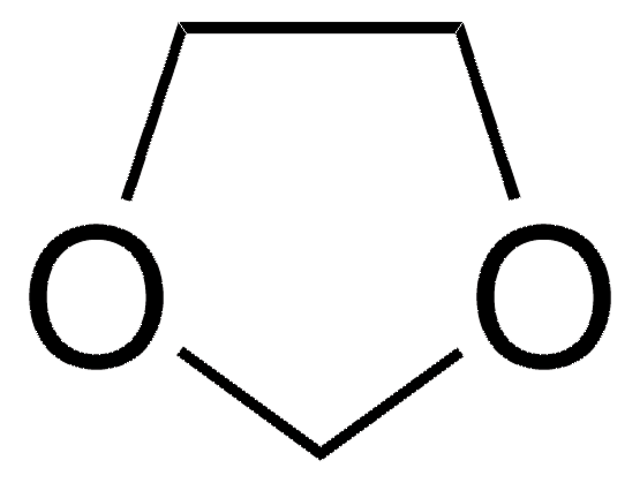930938
Lithium nitrate
battery grade, 99.999% trace metals basis
Sinónimos:
Lithium salt of nitric acid
About This Item
Productos recomendados
grade
battery grade
Quality Level
assay
99.999% trace metals basis
form
powder
greener alternative product characteristics
Design for Energy Efficiency
Learn more about the Principles of Green Chemistry.
sustainability
Greener Alternative Product
impurities
≤15 ppm (trace metals analysis)
mp
264 °C (lit.)
solubility
soluble (H2O: highly soluble(lit.); alcohols: soluble(lit.); acetone: soluble(lit.))
application(s)
battery manufacturing
SMILES string
[Li+].[O-][N+]([O-])=O
InChI
1S/Li.NO3/c;2-1(3)4/q+1;-1
InChI key
IIPYXGDZVMZOAP-UHFFFAOYSA-N
¿Está buscando productos similares? Visita Guía de comparación de productos
Categorías relacionadas
General description
Lithium nitrate is produced by reacting nitric acid and lithium carbonate, which evolves carbon dioxide and water. The resulting material is purified and dried.
Application
Our 99.999% lithium nitrate is also well-suited for use as an additive to electrolytes in lithium-sulfur batteries and lithium metal batteries. Lithium nitrate can passivate the surface of lithium metal and suppress the redox shuttle of the dissolved lithium polysulfides on the lithium anode. In one study, the addition of 0.3 M LiNO3 nearly doubled the gravimetric capacity of lithium-sulfide batteries. Another study found that the dissolution of 1 to 5 wt% LiNO3 to the electrolyte suppressed growth of lithium dendrites and extended cycle lifetimes. Similarly beneficial effects of lithium nitrate as an additive have been observed with Li2S cathodes, carbon nanofiber-encapsulated sulfur cathodes, cobalt sulfide (Co3S4) cathodes, and polyacrylonitrile-sulfur composite cathodes. Even lithium metal anodes with LiNi0.8Co0.15Al0.05O2 (NCA) cathodes with LiNO3 added to the electrolyte showed higher coulombic efficiencies and suppressed dendrite formation compared to the electrolyte without LiNO3.
signalword
Warning
hcodes
Hazard Classifications
Acute Tox. 4 Oral - Eye Irrit. 2 - Ox. Sol. 3
Storage Class
5.1B - Oxidizing hazardous materials
wgk_germany
WGK 1
flash_point_f
Not applicable
flash_point_c
Not applicable
Elija entre una de las versiones más recientes:
Certificados de análisis (COA)
It looks like we've run into a problem, but you can still download Certificates of Analysis from our Documentos section.
Si necesita más asistencia, póngase en contacto con Atención al cliente
¿Ya tiene este producto?
Encuentre la documentación para los productos que ha comprado recientemente en la Biblioteca de documentos.
Nuestro equipo de científicos tiene experiencia en todas las áreas de investigación: Ciencias de la vida, Ciencia de los materiales, Síntesis química, Cromatografía, Analítica y muchas otras.
Póngase en contacto con el Servicio técnico






